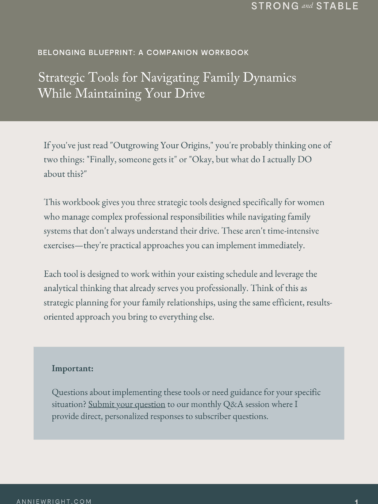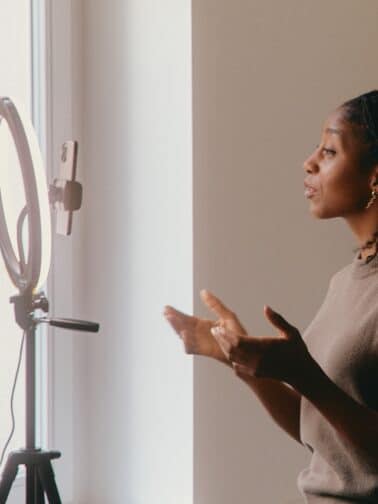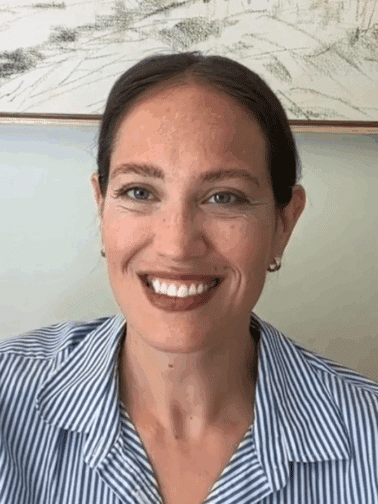There she sits at her granite kitchen counter at 9:42 PM, the blue glow of her phone casting harsh shadows across her exhausted face. The cold surface beneath her forearms contrasts sharply with the warmth of the mug of chamomile tea growing cold beside her—a failed attempt at winding down. Her color-coded calendar app glows up at her like a slot machine, each hour of busyness claimed by someone or something else.
The familiar weight of three project deadlines presses down on her shoulders like a heavy coat she can’t take off. The school board meeting she needs to prep for tomorrow morning. Her daughter’s soccer tournament this weekend, where she already knows she’ll find herself answering “urgent” emails from the sidelines while missing the goals. And somewhere in the busyness and mental chaos, that nagging reminder about the doctor’s appointment she keeps rescheduling—the one about the mole that’s been bothering her for months.
She rolls her shoulders against the familiar tension headache forming at the base of her skull. There’s that heaviness in her chest again—the one that always surfaces during rare quiet moments like silt settling in still water.
But instead of sitting with it, her thumb moves instinctively. She finds an empty half-hour on Thursday and quickly fills it with a conference call that could easily be an email.
The relief floods through her immediately.
The calendar is full again. Crisis averted.
Or is it?
If this scene feels uncomfortably familiar, you’re far from alone.
Here’s what I’ve noticed across hundreds of therapy sessions with high-achieving women: we’ve turned busyness into armor. A sophisticated shield that protects us from feelings we’re not ready to face.
“Busy” has become our automatic response to “How are you?” We humble-brag about our overwhelming to-do lists while secretly feeling important because we’re in constant demand.
But what if your jam-packed calendar serves a purpose beyond productivity?
What if busyness isn’t just about getting things done—what if it’s about keeping something else at bay?
Busyness as Armor: The Brilliant Strategy Hidden in Plain Sight
Let me be clear from the start: using busyness as protection is a brilliant adaptive strategy. Your mind developed this creative solution to help you cope with difficult feelings or circumstances.
This wasn’t a personal failure.
Recent research has revealed something fascinating about high-achievers: achievement can function as a socially acceptable form of emotional numbing—just as effective as more obvious escapes like alcohol or endless social media scrolling. The difference? Busyness earns praise rather than concern from others. It comes with gold stars instead of worried looks.
Think of busyness as emotional body armor. Heavy, protective, and highly effective—until it starts weighing you down so much that you can barely move.
I’ve walked this road myself. As a newly licensed therapist building my practice while managing my own thirties-related pressures, I recognize the seductive pull of a packed calendar. The way achievement temporarily quiets that inner voice questioning whether you’re enough. The dopamine hit of crossing items off endless to-do lists. The external validation that comes with being seen as someone who “has it all together.”
But if you’ve ever felt a wave of anxiety when faced with an empty day, or found yourself filling free time before it even arrives, it might be time to gently explore what your busyness is protecting you from. And whether that protection is now coming at too high a cost.
Why Doesn’t Your Success Feel as Good as It Looks?
A quiz to help you understand why you might feel less stable beneath the surface despite working so hard to build a good life.
START THE QUIZ
What Lives Beneath the Calendar: Understanding What We’re Really Avoiding
When we peel back the layers of constant activity, we often find specific, uncomfortable emotions waiting underneath. These aren’t random feelings. They’re particular ones that busyness helps us avoid or postpone. They’re the feelings that feel too big, too messy, or too threatening to our carefully constructed sense of control.
- Loneliness and the fear of abandonment. For many high-achieving women, especially those who experienced emotional inconsistency in childhood, unstructured time can trigger profound feelings of loneliness. The calendar full of meetings and calls ensures you’re always connected to someone, even if those connections remain at a safe, professional distance. Busy means needed. Needed feels safer than alone.
- Grief and unprocessed loss. Loss comes in many forms—the obvious ones like death or divorce, and the subtler ones like the career path not taken, the relationship that didn’t work out, or the version of yourself you thought you’d become. Constant activity creates little space for these grief feelings to surface. When every moment is accounted for, there’s no room for sadness to emerge.
- Feelings of inadequacy or “not-enoughness.” Achievement temporarily quiets that inner critic questioning your worth. Each completed task becomes evidence against the nagging feeling that you’re somehow not enough. Productivity becomes proof of value.
- Anxiety about the future. Planning and scheduling create an illusion of certainty in an inherently uncertain world. The more detailed the plan, the safer it feels. Control over your calendar feels like control over your life.
- Relationship tensions. Work provides a socially acceptable reason to avoid addressing difficulties in personal relationships. “I’d love to talk about our issues, but I have this deadline” becomes a pattern that keeps emotional intimacy at bay. Professional urgency trumps personal vulnerability every time.
Here’s what’s particularly striking: research shows that “time affluence”—having open, unstructured time—paradoxically creates more anxiety in high-achievers than time scarcity. Brain imaging studies reveal heightened activity in the fear center during unstructured time, similar to what’s observed during actual threat situations.
In other words, for many high-achievers, an empty calendar feels genuinely threatening to the nervous system.
Let me share a story about a former client that illustrates this perfectly. Elise was a 38-year-old marketing executive who came to me after her doctor suggested therapy for chronic migraines. She sat in my office that first day, back ramrod straight, her color-coded planner open on her lap like a security blanket. Her calendar was organized down to the minute—meetings blocked in blue, project deadlines in red, personal appointments in green.
“I pride myself on my efficiency,” she told me, her voice carrying the weight of exhaustion beneath its professional polish. “I can juggle multiple projects without dropping the ball. My team depends on me.”
During our third session, I asked what might happen if she had an entire Sunday with nothing scheduled. Her response was immediate, visceral.
“I’d probably lose my mind,” she said, laughing nervously while her hand instinctively moved to her planner. “Seriously, I get this knot in my stomach just thinking about it. I’d end up working anyway, just to make the feeling go away.”
When we explored this further, Elise realized that unstructured time brought up feelings of worthlessness she’d experienced growing up with a mother who criticized her for being “lazy” whenever she wasn’t productive. Her packed calendar wasn’t just about accomplishment—it was sophisticated protection against those painful childhood feelings that whispered she was only valuable when she was useful.
This is how our protective systems work. A packed schedule provides a sense of control when our internal states feel chaotic. There’s the dopamine hit of checking items off lists. The external validation that comes with visible productivity. The clear metrics of success that personal emotional work simply doesn’t provide.
Achievement and constant activity become shields against vulnerability:
“If I’m indispensable, I can’t be abandoned.”
“If I’m always helping others, I don’t have to face my own needs.”
“If I’m constantly achieving, I must be worthy.”
These unconscious beliefs drive the compulsion to fill every moment, answer every email immediately, and take on more responsibilities even when we’re already overwhelmed.
When Your Body Speaks What Your Mind Won’t Admit
While our minds excel at rationalization (“I’m just dedicated,” “This is what success requires,” “Everyone is this busy”), our bodies often tell a different story. The physical manifestations of using busyness as escape create their own language of warning—if we’re willing to listen.
Chronic tension and muscle pain, especially in the neck, shoulders, and jaw. Sleep problems—difficulty falling asleep due to racing thoughts or waking with anxiety already coursing through your system. Digestive issues that medical tests can’t fully explain. Frequent minor illnesses as your immune system struggles to keep up. Exhaustion masked by caffeine dependence.
Your nervous system doesn’t lie. When it remains in a chronic state of sympathetic activation—what we call “fight-or-flight”—your body experiences measurable changes. Increased stress hormones. Muscle tension. Digestive slowdown. Immune suppression.
In everyday terms, when your body’s alarm system stays “on” for too long, your physical health starts sending you increasingly urgent warning signals.
Another former client, Rebecca, came to me complaining of persistent digestive issues that stumped multiple medical specialists. She was a 42-year-old financial advisor and mother of two who managed her household with military precision while growing her client base by 30% annually. Her days started at 5:30 AM with gym sessions that felt more like obligations than self-care, followed by back-to-back client meetings, school pickups, dinner prep, homework supervision, and evening calls with West Coast clients.
“I don’t understand it,” she told me during our first session, her fingers unconsciously massaging her stomach. “I eat well, I exercise, I take vitamins. The doctors can’t find anything wrong.”
During one session, I asked her to track when her symptoms flared up. A week later, she returned with a revelation that stopped her cold.
“It’s the strangest thing,” she said, staring at her tracking sheet with genuine confusion. “The pain is worst on Sunday afternoons and vacation days. When I should be relaxing.”
“What happens during those times?” I asked.
“Nothing. That’s when I’m supposed to be resting,” she replied, then paused, her voice growing smaller. “But I feel guilty about resting, so I end up checking email or organizing something around the house. I can’t just… be.”
Rebecca’s body was literally rejecting the pattern of using busyness to avoid the discomfort of unstructured time. Her digestive system was speaking a truth her conscious mind wasn’t ready to acknowledge: the very times when she was “supposed” to rest were when her anxiety spiked highest.
This highlights something crucial: there’s a difference between energizing productivity and draining, avoidant activity. Meaningful work aligned with your values can be invigorating, life-giving even. Busyness for the sake of avoiding feelings typically leaves you depleted, running on fumes while trying to convince yourself you’re fulfilled.
The quality of your attention tells the story too. When you’re engaged in meaningful activity, you’re fully present—time can even seem to slow down or speed up in that flow state we all crave. When you’re busy as avoidance, there’s often a scattered quality to your attention—you’re physically doing one thing while your mind races to the next, constantly future-focused, never quite here.
And the aftermath reveals everything: Does completing your tasks leave you fulfilled or empty? Energized or exhausted? Connected to your purpose or feeling like you’re running on a treadmill going nowhere?
When Protection Becomes Prison: The Hidden Costs of Constant Motion
The very strategies that protect us can eventually confine us. What begins as a clever way to manage difficult feelings can gradually become a prison that cuts us off from essential aspects of human experience. The armor that once felt protective starts to feel heavy, restrictive, suffocating.
The busyness that once felt like safety leads to profound disconnection—from yourself, from loved ones, from genuine joy.
- Disconnection from yourself. When every moment fills with doing, you lose touch with your own needs, desires, and emotions. You may find yourself unsure of what you actually want versus what you think you should want. The constant external focus leaves little energy for internal awareness. You become a stranger to your own inner landscape.
- Disconnection from loved ones. Physical presence isn’t the same as emotional presence, and our loved ones feel the difference acutely. You might be in the same room with your partner or children while mentally reviewing your to-do list or checking your phone. This creates a painful paradox: you’re working hard ostensibly to provide for the people you love while simultaneously being unavailable to truly connect with them.
- Disconnection from genuine joy. Achievement provides a temporary high, but it’s different from authentic happiness that comes from presence, connection, and meaning. When we’re constantly focused on the next task, we miss the moments of wonder and beauty that give life its depth—the way morning light falls across your kitchen table, your child’s spontaneous laughter, the satisfaction of a conversation that goes deeper than logistics.
The cost of avoiding feelings through busyness runs deep: diminished capacity for intimacy, reduced creativity and intuition that require emotional access, loss of presence, and the exhaustion of maintaining the façade of having it all together.
Let me tell you about Sophia, a 36-year-old surgeon who sought therapy after her 7-year-old daughter made a comment that shook her to her core.
“My daughter drew a family picture for school,” Sophia told me, her voice tight with emotion she was trying to contain. “She drew me with a phone in one hand and a laptop in the other. When her teacher asked about it, she said, ‘That’s how I always see Mommy.'”
Sophia had built an impressive career while maintaining a perfectly organized home and serving on multiple hospital committees. Her reputation was spotless, her efficiency legendary among her colleagues. But her daughter’s drawing revealed the emotional cost of her protective strategy with brutal clarity.
“I’m physically there, but I’m not really present,” she admitted, finally allowing tears to fall. “I realize I’ve been using work to avoid the messiness of real connection. It’s easier to perform a complicated procedure than to sit on the floor and play a game with no clear outcome, no metrics for success.”
What started as a strategy to excel had become a barrier to what Sophia valued most—genuine connection with her daughter.
For many women, the moment of realization comes through a wake-up call like Sophia’s. A health scare. A relationship ultimatum. Seeing their own patterns reflected in their children. Or simply reaching a breaking point where the exhaustion outweighs the perceived benefits of constant busyness.
This realization often brings mixed emotions—grief for lost time, fear of what lies on the other side of busyness, and sometimes anger at the systems and conditioning that led here. These feelings are all normal parts of the process of change. They’re signs that you’re waking up, not that you’re doing something wrong.
Finding a Different Kind of Safety: The Permission to Slow Down
If you recognize yourself in this pattern of using busyness as protection, the first step is simple but profound: giving yourself permission to slow down. Not permission from others—permission from yourself.
This isn’t about abandoning your ambitions or responsibilities. It’s about challenging the belief system that equates slowing down with danger, laziness, or unworthiness. It’s about recognizing that your value exists independent of your productivity.
Dr. Brené Brown’s 2022 research on perfectionism and achievement reveals something powerful: the most resilient high-achievers are those who can separate their worth from their work. They maintain ambition without making it the sole source of their identity or safety.
This separation doesn’t happen overnight. It’s a gradual process of creating small moments of stillness and learning to tolerate the discomfort that initially arises. It’s about building a different kind of safety—one based on self-compassion rather than external validation.
Here are some gentle first steps that have helped my clients begin this journey:
- Start with micro-pauses. Dr. Dan Siegel’s 2023 research on “micro-practices” shows that even 30-second pauses throughout the day can begin rewiring the nervous system’s relationship with stillness. Try setting a gentle alarm three times daily as a reminder to take three conscious breaths, noticing your feet on the ground, and checking in with yourself.
- Create a “worry window.” Schedule 15 minutes daily to write down all your worries and concerns without trying to solve them. This practice, supported by Dr. Judson Brewer’s 2022 research on anxiety, helps contain worry rather than letting it infiltrate every moment. It acknowledges your concerns while creating boundaries around them.
- Practice the “sacred pause” before responding. When requests come in, give yourself permission to say, “Let me check my calendar and get back to you” rather than automatically saying yes. This small space between stimulus and response builds the muscle of choice rather than reactivity.
- Experiment with “being” activities. These are activities without productive outcomes—watching clouds move across the sky, listening to music without doing anything else, sitting in nature without your phone. Start with just five minutes and notice what arises.
- Develop a “completion practice.” Dr. Emily Nagoski’s 2021 research on “completing the stress cycle” shows how important it is to signal to your body that work is done. Create a simple end-of-workday ritual—changing clothes, a short walk, a cup of tea—that helps your nervous system understand it’s safe to shift modes.
Jamie, a 41-year-old attorney and another former client, found that her relationship with busyness began to shift when she started what she called her “transition ritual”—five minutes of sitting in her car after work before entering her home. No phone, no radio, just breathing and noticing.
“It felt excruciating at first,” she told me. “Those five minutes felt like an hour. My mind would race through all the things waiting for me inside—dinner prep, kids’ homework, household tasks. But gradually, something shifted. That small pause became sacred to me. It helped me leave work mode behind and actually be present when I walked through the door.”
The most powerful shift happened three months into this practice when Jamie’s 10-year-old son commented, “Mom, you listen different now.” Not “more” or “better”—but “different.” Present in a way that was palpable even to a child.
This is the promise of finding safety beyond busyness: not just reduced stress or better health outcomes (though research confirms these benefits), but a profound shift in how we experience our lives and relationships. A return to presence that makes space for both productivity and connection, achievement and joy.
The Courage to Feel What’s Been Waiting
As you begin creating small pockets of stillness in your life, difficult feelings will likely arise. This isn’t a sign that you’re doing something wrong—it’s evidence that you’re finally creating space for emotions that have been patiently waiting for your attention.
Dr. Tara Brach’s 2023 research on “radical acceptance” shows that acknowledging uncomfortable emotions actually reduces their intensity over time. Her clinical studies with high-achieving professionals demonstrate that the simple act of making space for feelings—rather than trying to fix or avoid them—leads to greater emotional regulation and resilience.
This doesn’t mean you need to face your deepest wounds all at once. It means developing a gentle, curious relationship with your emotional landscape—noticing what arises when you slow down without immediately trying to change or escape it.
You might discover grief for opportunities missed while you were too busy to notice them. Anger at systems that equate worth with productivity. Fear about who you are without your achievements. Sadness for relationships that suffered while work took precedence.
These feelings aren’t enemies to vanquish. They’re messengers carrying important information about your needs, values, and boundaries. When we create space to listen to them, they often transform naturally, without force.
The journey from using busyness as protection to finding safety in your own being isn’t linear. There will be days when old patterns resurface, when the to-do list feels safer than the open space of a Sunday afternoon. This isn’t failure—it’s part of the process of rewiring patterns that may have been in place for decades.
What matters isn’t perfection but direction—the gradual shift from external validation to internal worth, from constant doing to the courage of sometimes simply being.
A Different Kind of Safety Awaits
The most profound shift I’ve witnessed in clients who move beyond using busyness as protection isn’t just better time management or reduced stress—though these are welcome benefits. It’s a fundamental change in their relationship with themselves and their worth.
They discover that they are enough, even in stillness. That their value exists independent of their output. That connection flourishes in the spaces between achievements.
They learn that safety can come from presence rather than productivity. From self-compassion rather than self-optimization. From being rather than endless doing.
This doesn’t mean abandoning ambition or responsibility. Many continue building impressive careers and managing full lives. The difference is they no longer need constant activity to feel worthy or safe. They’ve developed the capacity to move between doing and being with greater fluidity and less fear.
If you recognize yourself in the patterns I’ve described, I want you to know that a different relationship with busyness is possible. Your packed calendar has served an important protective function, but it doesn’t have to be your only source of safety forever.
The first step is simply awareness—noticing when you’re filling time to avoid feelings. The second is self-compassion for the brilliant way your mind created this protection. And the third is the gentle, gradual practice of creating small moments of stillness where you can begin to feel safe without the shield of constant activity.
Your worth has never been measured by the fullness of your calendar. It exists, complete and unchanging, in the simple fact of your being.
Warmly,
Annie
References
- Brown, B. (2022). Atlas of the Heart: Mapping Meaningful Connection and the Language of Human Experience. Random House.
- Siegel, D. (2023). Intraconnected: MWe (Me + We) as the Integration of Self, Identity, and Belonging. W.W. Norton & Company.
- Brewer, J. (2022). Unwinding Anxiety: New Science Shows How to Break the Cycles of Worry and Fear to Heal Your Mind. Avery.
- Nagoski, E. (2021). Burnout: The Secret to Unlocking the Stress Cycle. Ballantine Books.
- Brach, T. (2023). Radical Acceptance: Embracing Your Life With the Heart of a Buddha (Updated edition). Bantam.





